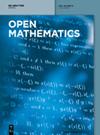求助PDF
{"title":"模块类二级谱上的扎里斯基拓扑学","authors":"Saif Salam, Khaldoun Al-Zoubi","doi":"10.1515/math-2024-0005","DOIUrl":null,"url":null,"abstract":"Let <jats:inline-formula> <jats:alternatives> <jats:inline-graphic xmlns:xlink=\"http://www.w3.org/1999/xlink\" xlink:href=\"graphic/j_math-2024-0005_eq_001.png\" /> <m:math xmlns:m=\"http://www.w3.org/1998/Math/MathML\"> <m:mi>ℜ</m:mi> </m:math> <jats:tex-math>\\Re </jats:tex-math> </jats:alternatives> </jats:inline-formula> be a commutative ring with unity and <jats:inline-formula> <jats:alternatives> <jats:inline-graphic xmlns:xlink=\"http://www.w3.org/1999/xlink\" xlink:href=\"graphic/j_math-2024-0005_eq_002.png\" /> <m:math xmlns:m=\"http://www.w3.org/1998/Math/MathML\"> <m:mi>ℑ</m:mi> </m:math> <jats:tex-math>\\Im </jats:tex-math> </jats:alternatives> </jats:inline-formula> be a left <jats:inline-formula> <jats:alternatives> <jats:inline-graphic xmlns:xlink=\"http://www.w3.org/1999/xlink\" xlink:href=\"graphic/j_math-2024-0005_eq_003.png\" /> <m:math xmlns:m=\"http://www.w3.org/1998/Math/MathML\"> <m:mi>ℜ</m:mi> </m:math> <jats:tex-math>\\Re </jats:tex-math> </jats:alternatives> </jats:inline-formula>-module. We define the secondary-like spectrum of <jats:inline-formula> <jats:alternatives> <jats:inline-graphic xmlns:xlink=\"http://www.w3.org/1999/xlink\" xlink:href=\"graphic/j_math-2024-0005_eq_004.png\" /> <m:math xmlns:m=\"http://www.w3.org/1998/Math/MathML\"> <m:mi>ℑ</m:mi> </m:math> <jats:tex-math>\\Im </jats:tex-math> </jats:alternatives> </jats:inline-formula> to be the set of all secondary submodules <jats:inline-formula> <jats:alternatives> <jats:inline-graphic xmlns:xlink=\"http://www.w3.org/1999/xlink\" xlink:href=\"graphic/j_math-2024-0005_eq_005.png\" /> <m:math xmlns:m=\"http://www.w3.org/1998/Math/MathML\"> <m:mi>K</m:mi> </m:math> <jats:tex-math>K</jats:tex-math> </jats:alternatives> </jats:inline-formula> of <jats:inline-formula> <jats:alternatives> <jats:inline-graphic xmlns:xlink=\"http://www.w3.org/1999/xlink\" xlink:href=\"graphic/j_math-2024-0005_eq_006.png\" /> <m:math xmlns:m=\"http://www.w3.org/1998/Math/MathML\"> <m:mi>ℑ</m:mi> </m:math> <jats:tex-math>\\Im </jats:tex-math> </jats:alternatives> </jats:inline-formula> such that the annihilator of the socle of <jats:inline-formula> <jats:alternatives> <jats:inline-graphic xmlns:xlink=\"http://www.w3.org/1999/xlink\" xlink:href=\"graphic/j_math-2024-0005_eq_007.png\" /> <m:math xmlns:m=\"http://www.w3.org/1998/Math/MathML\"> <m:mi>K</m:mi> </m:math> <jats:tex-math>K</jats:tex-math> </jats:alternatives> </jats:inline-formula> is the radical of the annihilator of <jats:inline-formula> <jats:alternatives> <jats:inline-graphic xmlns:xlink=\"http://www.w3.org/1999/xlink\" xlink:href=\"graphic/j_math-2024-0005_eq_008.png\" /> <m:math xmlns:m=\"http://www.w3.org/1998/Math/MathML\"> <m:mi>K</m:mi> </m:math> <jats:tex-math>K</jats:tex-math> </jats:alternatives> </jats:inline-formula>, and we denote it by <jats:inline-formula> <jats:alternatives> <jats:inline-graphic xmlns:xlink=\"http://www.w3.org/1999/xlink\" xlink:href=\"graphic/j_math-2024-0005_eq_009.png\" /> <m:math xmlns:m=\"http://www.w3.org/1998/Math/MathML\"> <m:msup> <m:mrow> <m:mi mathvariant=\"normal\">Spec</m:mi> </m:mrow> <m:mrow> <m:mi>L</m:mi> </m:mrow> </m:msup> <m:mrow> <m:mo>(</m:mo> <m:mrow> <m:mi>ℑ</m:mi> </m:mrow> <m:mo>)</m:mo> </m:mrow> </m:math> <jats:tex-math>{{\\rm{Spec}}}^{L}\\left(\\Im )</jats:tex-math> </jats:alternatives> </jats:inline-formula>. In this study, we introduce a topology on <jats:inline-formula> <jats:alternatives> <jats:inline-graphic xmlns:xlink=\"http://www.w3.org/1999/xlink\" xlink:href=\"graphic/j_math-2024-0005_eq_010.png\" /> <m:math xmlns:m=\"http://www.w3.org/1998/Math/MathML\"> <m:msup> <m:mrow> <m:mi mathvariant=\"normal\">Spec</m:mi> </m:mrow> <m:mrow> <m:mi>L</m:mi> </m:mrow> </m:msup> <m:mrow> <m:mo>(</m:mo> <m:mrow> <m:mi>ℑ</m:mi> </m:mrow> <m:mo>)</m:mo> </m:mrow> </m:math> <jats:tex-math>{{\\rm{Spec}}}^{L}\\left(\\Im )</jats:tex-math> </jats:alternatives> </jats:inline-formula> having the Zariski topology on the second spectrum <jats:inline-formula> <jats:alternatives> <jats:inline-graphic xmlns:xlink=\"http://www.w3.org/1999/xlink\" xlink:href=\"graphic/j_math-2024-0005_eq_011.png\" /> <m:math xmlns:m=\"http://www.w3.org/1998/Math/MathML\"> <m:msup> <m:mrow> <m:mi mathvariant=\"normal\">Spec</m:mi> </m:mrow> <m:mrow> <m:mi>s</m:mi> </m:mrow> </m:msup> <m:mrow> <m:mo>(</m:mo> <m:mrow> <m:mi>ℑ</m:mi> </m:mrow> <m:mo>)</m:mo> </m:mrow> </m:math> <jats:tex-math>{{\\rm{Spec}}}^{s}\\left(\\Im )</jats:tex-math> </jats:alternatives> </jats:inline-formula> as a subspace topology and study several topological structures of this topology.","PeriodicalId":48713,"journal":{"name":"Open Mathematics","volume":"13 1","pages":""},"PeriodicalIF":1.0000,"publicationDate":"2024-04-05","publicationTypes":"Journal Article","fieldsOfStudy":null,"isOpenAccess":false,"openAccessPdf":"","citationCount":"0","resultStr":"{\"title\":\"Zariski topology on the secondary-like spectrum of a module\",\"authors\":\"Saif Salam, Khaldoun Al-Zoubi\",\"doi\":\"10.1515/math-2024-0005\",\"DOIUrl\":null,\"url\":null,\"abstract\":\"Let <jats:inline-formula> <jats:alternatives> <jats:inline-graphic xmlns:xlink=\\\"http://www.w3.org/1999/xlink\\\" xlink:href=\\\"graphic/j_math-2024-0005_eq_001.png\\\" /> <m:math xmlns:m=\\\"http://www.w3.org/1998/Math/MathML\\\"> <m:mi>ℜ</m:mi> </m:math> <jats:tex-math>\\\\Re </jats:tex-math> </jats:alternatives> </jats:inline-formula> be a commutative ring with unity and <jats:inline-formula> <jats:alternatives> <jats:inline-graphic xmlns:xlink=\\\"http://www.w3.org/1999/xlink\\\" xlink:href=\\\"graphic/j_math-2024-0005_eq_002.png\\\" /> <m:math xmlns:m=\\\"http://www.w3.org/1998/Math/MathML\\\"> <m:mi>ℑ</m:mi> </m:math> <jats:tex-math>\\\\Im </jats:tex-math> </jats:alternatives> </jats:inline-formula> be a left <jats:inline-formula> <jats:alternatives> <jats:inline-graphic xmlns:xlink=\\\"http://www.w3.org/1999/xlink\\\" xlink:href=\\\"graphic/j_math-2024-0005_eq_003.png\\\" /> <m:math xmlns:m=\\\"http://www.w3.org/1998/Math/MathML\\\"> <m:mi>ℜ</m:mi> </m:math> <jats:tex-math>\\\\Re </jats:tex-math> </jats:alternatives> </jats:inline-formula>-module. We define the secondary-like spectrum of <jats:inline-formula> <jats:alternatives> <jats:inline-graphic xmlns:xlink=\\\"http://www.w3.org/1999/xlink\\\" xlink:href=\\\"graphic/j_math-2024-0005_eq_004.png\\\" /> <m:math xmlns:m=\\\"http://www.w3.org/1998/Math/MathML\\\"> <m:mi>ℑ</m:mi> </m:math> <jats:tex-math>\\\\Im </jats:tex-math> </jats:alternatives> </jats:inline-formula> to be the set of all secondary submodules <jats:inline-formula> <jats:alternatives> <jats:inline-graphic xmlns:xlink=\\\"http://www.w3.org/1999/xlink\\\" xlink:href=\\\"graphic/j_math-2024-0005_eq_005.png\\\" /> <m:math xmlns:m=\\\"http://www.w3.org/1998/Math/MathML\\\"> <m:mi>K</m:mi> </m:math> <jats:tex-math>K</jats:tex-math> </jats:alternatives> </jats:inline-formula> of <jats:inline-formula> <jats:alternatives> <jats:inline-graphic xmlns:xlink=\\\"http://www.w3.org/1999/xlink\\\" xlink:href=\\\"graphic/j_math-2024-0005_eq_006.png\\\" /> <m:math xmlns:m=\\\"http://www.w3.org/1998/Math/MathML\\\"> <m:mi>ℑ</m:mi> </m:math> <jats:tex-math>\\\\Im </jats:tex-math> </jats:alternatives> </jats:inline-formula> such that the annihilator of the socle of <jats:inline-formula> <jats:alternatives> <jats:inline-graphic xmlns:xlink=\\\"http://www.w3.org/1999/xlink\\\" xlink:href=\\\"graphic/j_math-2024-0005_eq_007.png\\\" /> <m:math xmlns:m=\\\"http://www.w3.org/1998/Math/MathML\\\"> <m:mi>K</m:mi> </m:math> <jats:tex-math>K</jats:tex-math> </jats:alternatives> </jats:inline-formula> is the radical of the annihilator of <jats:inline-formula> <jats:alternatives> <jats:inline-graphic xmlns:xlink=\\\"http://www.w3.org/1999/xlink\\\" xlink:href=\\\"graphic/j_math-2024-0005_eq_008.png\\\" /> <m:math xmlns:m=\\\"http://www.w3.org/1998/Math/MathML\\\"> <m:mi>K</m:mi> </m:math> <jats:tex-math>K</jats:tex-math> </jats:alternatives> </jats:inline-formula>, and we denote it by <jats:inline-formula> <jats:alternatives> <jats:inline-graphic xmlns:xlink=\\\"http://www.w3.org/1999/xlink\\\" xlink:href=\\\"graphic/j_math-2024-0005_eq_009.png\\\" /> <m:math xmlns:m=\\\"http://www.w3.org/1998/Math/MathML\\\"> <m:msup> <m:mrow> <m:mi mathvariant=\\\"normal\\\">Spec</m:mi> </m:mrow> <m:mrow> <m:mi>L</m:mi> </m:mrow> </m:msup> <m:mrow> <m:mo>(</m:mo> <m:mrow> <m:mi>ℑ</m:mi> </m:mrow> <m:mo>)</m:mo> </m:mrow> </m:math> <jats:tex-math>{{\\\\rm{Spec}}}^{L}\\\\left(\\\\Im )</jats:tex-math> </jats:alternatives> </jats:inline-formula>. In this study, we introduce a topology on <jats:inline-formula> <jats:alternatives> <jats:inline-graphic xmlns:xlink=\\\"http://www.w3.org/1999/xlink\\\" xlink:href=\\\"graphic/j_math-2024-0005_eq_010.png\\\" /> <m:math xmlns:m=\\\"http://www.w3.org/1998/Math/MathML\\\"> <m:msup> <m:mrow> <m:mi mathvariant=\\\"normal\\\">Spec</m:mi> </m:mrow> <m:mrow> <m:mi>L</m:mi> </m:mrow> </m:msup> <m:mrow> <m:mo>(</m:mo> <m:mrow> <m:mi>ℑ</m:mi> </m:mrow> <m:mo>)</m:mo> </m:mrow> </m:math> <jats:tex-math>{{\\\\rm{Spec}}}^{L}\\\\left(\\\\Im )</jats:tex-math> </jats:alternatives> </jats:inline-formula> having the Zariski topology on the second spectrum <jats:inline-formula> <jats:alternatives> <jats:inline-graphic xmlns:xlink=\\\"http://www.w3.org/1999/xlink\\\" xlink:href=\\\"graphic/j_math-2024-0005_eq_011.png\\\" /> <m:math xmlns:m=\\\"http://www.w3.org/1998/Math/MathML\\\"> <m:msup> <m:mrow> <m:mi mathvariant=\\\"normal\\\">Spec</m:mi> </m:mrow> <m:mrow> <m:mi>s</m:mi> </m:mrow> </m:msup> <m:mrow> <m:mo>(</m:mo> <m:mrow> <m:mi>ℑ</m:mi> </m:mrow> <m:mo>)</m:mo> </m:mrow> </m:math> <jats:tex-math>{{\\\\rm{Spec}}}^{s}\\\\left(\\\\Im )</jats:tex-math> </jats:alternatives> </jats:inline-formula> as a subspace topology and study several topological structures of this topology.\",\"PeriodicalId\":48713,\"journal\":{\"name\":\"Open Mathematics\",\"volume\":\"13 1\",\"pages\":\"\"},\"PeriodicalIF\":1.0000,\"publicationDate\":\"2024-04-05\",\"publicationTypes\":\"Journal Article\",\"fieldsOfStudy\":null,\"isOpenAccess\":false,\"openAccessPdf\":\"\",\"citationCount\":\"0\",\"resultStr\":null,\"platform\":\"Semanticscholar\",\"paperid\":null,\"PeriodicalName\":\"Open Mathematics\",\"FirstCategoryId\":\"100\",\"ListUrlMain\":\"https://doi.org/10.1515/math-2024-0005\",\"RegionNum\":4,\"RegionCategory\":\"数学\",\"ArticlePicture\":[],\"TitleCN\":null,\"AbstractTextCN\":null,\"PMCID\":null,\"EPubDate\":\"\",\"PubModel\":\"\",\"JCR\":\"Q1\",\"JCRName\":\"MATHEMATICS\",\"Score\":null,\"Total\":0}","platform":"Semanticscholar","paperid":null,"PeriodicalName":"Open Mathematics","FirstCategoryId":"100","ListUrlMain":"https://doi.org/10.1515/math-2024-0005","RegionNum":4,"RegionCategory":"数学","ArticlePicture":[],"TitleCN":null,"AbstractTextCN":null,"PMCID":null,"EPubDate":"","PubModel":"","JCR":"Q1","JCRName":"MATHEMATICS","Score":null,"Total":0}
引用次数: 0
引用
批量引用


